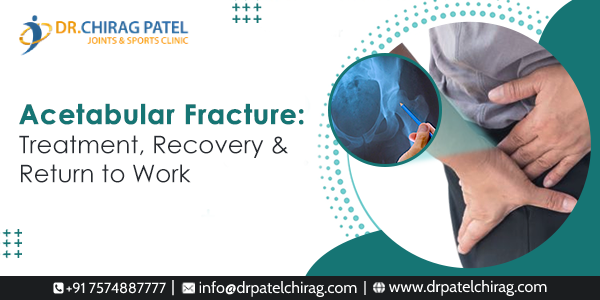The acetabulum is the socket in the ball-socket joint of the hip. Along with the femur (the ball), it forms a ball and socket joint to lend the hip excellent mobility in all directions. The fracture to this socket-like shaped acetabulum is called an acetabulum fracture (Acetabular Fracture).
This serious fracture that results in loss of motion and function is relatively uncommon as compared to hip fractures in general. “Not only does it causes severe hip pain, damages the nerves and but also increases the risk of developing post-traumatic arthritis which may require hip replacement”, says orthopaedic doctor and hip replacement in Mumbai Dr Chirag Patel.
The hip joint is one of the strongest joints in the human body and the Acetabulum fracture these days tend to happen in two cases:
- High-energy crashes, motorbike accidents or falls from significant heights- most common among the young.
- Low-energy crashes like falls from even standard height – more often happen in elder adults with osteoporosis.
So how are Acetabular Fractures treated and how is life after the treatment procedure, you can find us here:
Treatment Recovery and Life After Acetabular Fracture Treatment:
Fractures to the acetabulum are one of the most challenging orthopaedic injuries to repair. First thing, the fracture can happen in 10 different patterns each with its own level of severity. Second, injuries to the acetabulum can lead to fractured cartilage and bone at a challenging location which is difficult to repair. So we are often asked questions about the surgical treatment for Acetabulum fracture, life after the treatment – recovery and guidelines. With inputs from an orthopaedic doctor and hip replacement specialist in Mumbai Dr Chirag Patel, we have provided the information in this blog here. Read on to know:
Treatment for Acetabular Fracture:
Three factors contribute to the type of treatment for Acetabulum Fracture:
- Type of fracture, pattern and break involved
- Stability of the pelvis after the fracture
- Degree of displacement of bones after a fracture.
After performing physical examination and imaging studies, the orthopaedic surgeon determines the type of procedure required to treat Acetabulum Fracture. Patients with stable pelvic fracture i.e. without dislocation of joint or displacement of the bones are treated with non-surgical treatment which involves closed reduction (realignment of the joint without surgery). This procedure is performed with or without external fixation. Crutches, leg positioning devices, pain relievers, and blood thinners are also employed during this treatment to ease the pain after the treatment.
A dislocated bone will need open reduction and internal fixation where the surgeon will realign the bones in their place with a surgical anchor. In most severe cases among elder adults, the acetabulum could be too weak or damaged to repair and this is when a hip replacement is recommended.
Recovery & Life after Acetabulum Fracture Treatment:
After surgery, patients will experience pain for which medications are prescribed. Patients may not be able to put their full weight on their legs which is why crutches and walkers are suggested to assist in walking.
Patients will not be able to engage in physical activity for 6-12 months. Physical therapy is recommended, low impact exercises are suggested to aid this process. The recovery timeline may vary based on the severity of the fracture, age and medical history. Depending on these factors there is also a risk of arthritis which shall be discussed by the surgeon after the procedure. For more information on treatment, recovery and life after Acetabular Fracture, you can contact the top orthopaedic surgeon and hip replacement specialist in Mumbai Dr Chirag Patel.





